- Home
- Features
- Movies/Media
- Collectibles
- Comics/Books
-
Databases
-
Figure Database
>
-
X-Plus Toho/Daiei/Other
>
- X-Plus 30 cm Godzilla/Toho Part One
- X-Plus 30 cm Godzilla/Toho Part Two
- X-Plus Large Monster Series Godzilla/Toho Part One
- X-Plus Large Monster Series Godzilla/Toho Part Two
- X-Plus Godzilla/Toho Pre-2007
- X-Plus Godzilla/Toho Gigantic Series
- X-Plus Daiei/Pacific Rim/Other
- X-Plus Daiei/Other Pre-2009
- X-Plus Toho/Daiei DefoReal/More Part One
- X-Plus Toho/Daiei DefoReal/More Part Two
- X-Plus Godzilla/Toho Other Figure Lines
- X-Plus Classic Creatures & More
- Star Ace/X-Plus Classic Creatures & More
-
X-Plus Ultraman
>
- X-Plus Ultraman Pre-2012 Part One
- X-Plus Ultraman Pre-2012 Part Two
- X-Plus Ultraman 2012 - 2013
- X-Plus Ultraman 2014 - 2015
- X-Plus Ultraman 2016 - 2017
- X-Plus Ultraman 2018 - 2019
- X-Plus Ultraman 2020 - 2021
- X-Plus Ultraman 2022 - 2023
- X-Plus Ultraman Gigantics/DefoReals
- X-Plus Ultraman RMC
- X-Plus Ultraman RMC Plus
- X-Plus Ultraman Other Figure Lines
- X-Plus Tokusatsu
- Bandai/Tamashii >
- Banpresto
- NECA >
- Medicom Toys >
- Kaiyodo/Revoltech
- Diamond Select Toys
- Funko/Jakks/Others
- Playmates Toys
- Art Spirits
- Mezco Toyz
-
X-Plus Toho/Daiei/Other
>
- Movie Database >
- Comic/Book Database >
-
Figure Database
>
- Marketplace
- Kaiju Addicts
|
Godzilla vs. King Ghidorah (ゴジラvsキングギドラ Gojira tai Kingu Gidora), is a 1991 Japanese science fiction kaiju film produced by Toho Co., Ltd.. Directed by Kazuki Omori, and featuring special effects by Koichi Kawakita, the film starred Anna Nakagawa, Megumi Odaka, and Akiji Kobayashi. The 18th installment in the Godzilla series, the film featured the return of Godzilla's greatest foe, the three-headed King Ghidorah. Tomoyuki Tanaka had originally desired to create new monster opponents for the series, but after the box office disappointment of 1989's Godzilla vs Biollante, opted to bring back classic foes instead. The film was a box office hit, with sequels released on a yearly basis until 1995. It won a Japanese Academy Award for special effects. The film was released direct to video in the United States in 1998 by Columbia Tristar Home Video as Godzilla vs. King Ghidora. 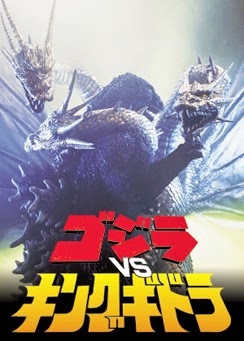 Plot Kenichiro Terasawa (Kosuke Toyohara), an author of books on psychic phenomena, believes he's discovered Godzilla's true origin. During World War II, a group of Japanese soldiers stationed on Lagos Island in South Pacific [2] were unintentionally saved by a Godzillasaurus, which attacked and killed a group of American soldiers who had landed on the island in February 1944 as part of the Gilbert and Marshall Islands campaign. While all of the Japanese soldiers on the nearby Islands fought and died to the last man, the Japanese soldiers on Lagos survived the war and eventually returned to Japan. In 1954, the island was destroyed by a hydrogen bomb test, just months before Godzilla first attacked Tokyo. Yasuaki Shindo (Yoshio Tsuchiya), who commanded the Japanese on Lagos, is now a wealthy businessman who denies the dinosaur's existence. Meanwhile, a UFO lands on Mount Fuji. When the army investigates, they are greeted by Wilson (Chuck Wilson), Grenchko (Richard Berger), Emmy Kano (Anna Nakagawa) and android M-11 (Robert Scott Field). The visitors, called the Futurians, explain that they're from the year 2204, a time long after Japan had been completely destroyed by Godzilla. They explain that they can time travel back to 1944 and remove the Godzillasaurus from Lagos, thereby avoiding the creation of Godzilla. As proof of their story, Emmy presents to the Japanese government a copy of Terasawa's book, which he hasn't even written yet. 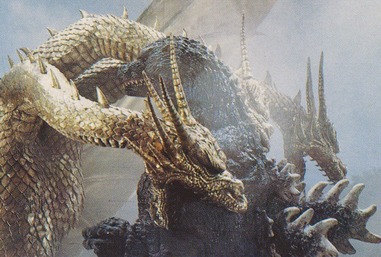 Terasawa, psychic Miki Saegusa (Megumi Odaka) and Professor Mazaki (Katsuhiko Sasaki) board a time shuttle and travel back to 1944. As American forces land on the island and engage the Japanese forces commanded by Shindo, the dinosaur attacks the American soldiers. However, subsequent bombardment from American naval vessels leaves it gravely wounded. Shindo and his men, after thanking the Godzillasaurus, withdraw. M-11 then teleports the dinosaur to an island in the Bering Sea. They then return to 1992, but not before releasing three, small artificial creatures called Dorats on Lagos. The radiation as a result of the nuclear test fuses them into King Ghidorah. The Futurians use Ghidorah in the present to subjugate Japan. They issue an ultimatum, but Japan refuses to surrender. Feeling sympathy for the Japanese, Emmy reveals the truth behind the Futurians' mission: in the future, Japan becomes very wealthy surpasses that of the United States, Russia and China. The Futurians in fact stole the time machine and plan to use King Ghidorah to alter the future by devastating present-day Japan, preventing its future economic reign. After she is returned to her ship by M-11, she reprograms the android. With his, and Terasawa's aid, they sabotage Ghidorah's control in the UFO. However, Emmy's companions reveal that their ship is bound to automatic time warp in the event of sabotage, allowing them to return to a future where Japan has been destroyed either way. 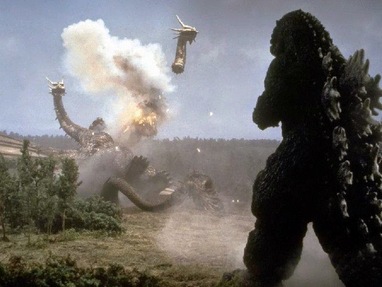 Shindo, meanwhile, believes that Godzilla can be re-created using his secret, nuclear submarine. But while on its mission, the submarine is destroyed by Godzilla; Terasawa learns that a Russian nuclear submarine sank in the same region the Godzillasaurus was teleported to, giving off enough radiation to create the same Godzilla who destroyed Tokyo in 1984. In an ironic twist of fate, the Futurians had not erased the original Godzilla from history, they had actually created the second and current Godzilla. Godzilla finally arrives in Japan and is greeted by King Ghidorah, who was sent by Wilson to destroy Godzilla. Godzilla and King Ghidorah have a long hard battle which eventually ends with Godzilla blasting the middle head of King Ghidorah. Before the final blow, Godzilla destroys the UFO, which was teleported by M-11 before it could time warp, killing Wilson and Grenchko. Japanase troops attack Godzilla in Sapporo, to no avail. He then turns his attention on Tokyo, destroying the metropolis. In the process, Shindo is killed; though not before he and Godzilla share a brief moment, where Godzilla is seemingly sad for once. Emmy, however, travels to the future and returns with Mecha-King Ghidorah, a resurrected cyborg version of the original creature. Battling in the heart of Tokyo, Emmy carries Godzilla off and drops the monster together with Ghidorah into the ocean. She then returns to the future in the time shuttle, but not before informing Terasawa that she is in fact a descendant of his. At the bottom of the sea, Godzilla recovers and roars over Mecha-King Ghidorah's remains. Cast
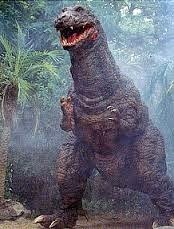 Production This film is set after the events of The Return of Godzilla (1984) and Godzilla vs. Biollante (1989). Originally, the film was to be a remake of King Kong vs. Godzilla with the title Godzilla vs. King Kong, but Turner Entertainment demanded too much money for the use of Kong. After this, Toho had the idea of making Godzilla vs. Mechani-Kong (from 1967's King Kong Escapes), but director Kazuki Omori feared that this would ultimately violate Turner's copyright as well. Toho eventually settled for Godzilla vs. King Ghidorah, pitting Godzilla against his archenemy from the original series. English Version After the film was released in Japan, Toho commissioned a Hong Kong company to dub the film into English. Instead of creating a unique title screen for the movie, as had been done with the previous international versions of Godzilla films, the international title for the film was simply superimposed over the Japanese title. 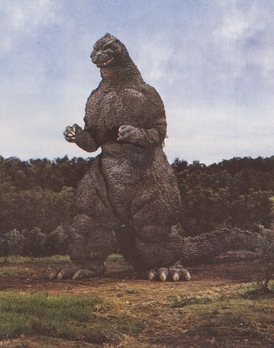 The complete international English version of Godzilla vs. King Ghidorah (except the opening Toho logos) was released on video in the United Kingdom by Manga Video on June 5, 1995. Manga similarly released the international version of Godzilla vs. Mothra on video less than a month later. In Italy, Yamato Video dubbed the international version of both movies into Italian, despite using complete international prints for both films. Columbia TriStar Home Entertainment released Godzilla vs. King Ghidorah and Godzilla vs. Mothra on home video on April 28, 1998. This was the first time either film had been officially released in the United States. TriStar used the Toho dubbed versions, but cut the end credits and created new titles and opening credits for both films. Some VHS copies of the film opened and closed with the 1984 TriStar Pictures logo. Box Office According to Toho, the film sold approximately 2,700,000 tickets in Japan, and grossed around $11,000,000 (U.S). Home Media Release (US) Columbia/Tristar Home Entertainment Released: November 10, 1998 Aspect Ratio: Full Frame (1.33:1) [NTSC] Sound: English (2.0) Supplements: Liner notes Case type: Keep Case Region 1 (DVD) Notes: Only in a double feature with “Godzilla and Mothra: The Battle for Earth (1992)". Blu-Ray will be coming out May 6, 2014 as a double feature with Godzilla vs. Mothra. Controversy
This film was considered controversial at the time of its release due to its fictional World War II sequence. The scene depicted American soldiers being killed by a Godzillasaurus, allowing Japanese soldiers to escape. The film's plot, involving Western villains from the future attempting to subjugate Japan, was also debated. Director Kazuki Ōmori defended his artistic decision on camera, arguing that the film was not in fact meant to be anti-American. It was also noted that there was considerable negative publicity regarding economic tensions between the United States and Japan at the time the film was made.
0 Comments
Leave a Reply. |
Release Dates
November 2023
|
|
© 2011-2024 Kaiju Battle. All Rights Reserved.
|
Visit Our Social Media Sites
|
Proudly powered by Weebly
|
- Home
- Features
- Movies/Media
- Collectibles
- Comics/Books
-
Databases
-
Figure Database
>
-
X-Plus Toho/Daiei/Other
>
- X-Plus 30 cm Godzilla/Toho Part One
- X-Plus 30 cm Godzilla/Toho Part Two
- X-Plus Large Monster Series Godzilla/Toho Part One
- X-Plus Large Monster Series Godzilla/Toho Part Two
- X-Plus Godzilla/Toho Pre-2007
- X-Plus Godzilla/Toho Gigantic Series
- X-Plus Daiei/Pacific Rim/Other
- X-Plus Daiei/Other Pre-2009
- X-Plus Toho/Daiei DefoReal/More Part One
- X-Plus Toho/Daiei DefoReal/More Part Two
- X-Plus Godzilla/Toho Other Figure Lines
- X-Plus Classic Creatures & More
- Star Ace/X-Plus Classic Creatures & More
-
X-Plus Ultraman
>
- X-Plus Ultraman Pre-2012 Part One
- X-Plus Ultraman Pre-2012 Part Two
- X-Plus Ultraman 2012 - 2013
- X-Plus Ultraman 2014 - 2015
- X-Plus Ultraman 2016 - 2017
- X-Plus Ultraman 2018 - 2019
- X-Plus Ultraman 2020 - 2021
- X-Plus Ultraman 2022 - 2023
- X-Plus Ultraman Gigantics/DefoReals
- X-Plus Ultraman RMC
- X-Plus Ultraman RMC Plus
- X-Plus Ultraman Other Figure Lines
- X-Plus Tokusatsu
- Bandai/Tamashii >
- Banpresto
- NECA >
- Medicom Toys >
- Kaiyodo/Revoltech
- Diamond Select Toys
- Funko/Jakks/Others
- Playmates Toys
- Art Spirits
- Mezco Toyz
-
X-Plus Toho/Daiei/Other
>
- Movie Database >
- Comic/Book Database >
-
Figure Database
>
- Marketplace
- Kaiju Addicts
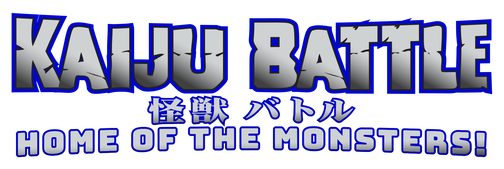
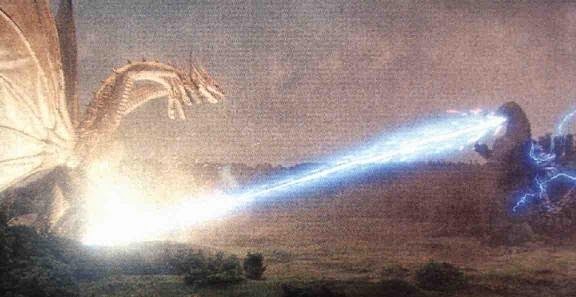
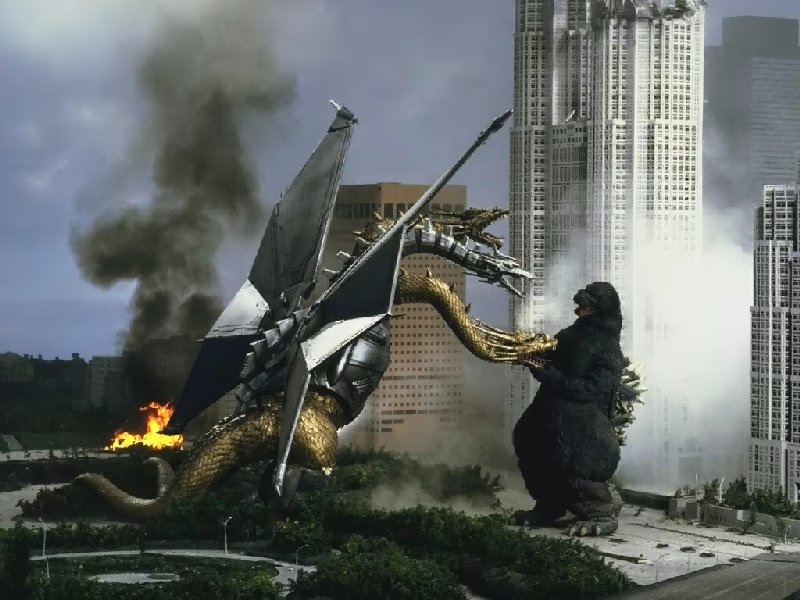
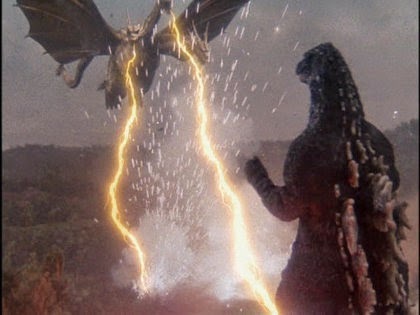
 RSS Feed
RSS Feed